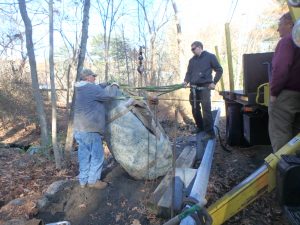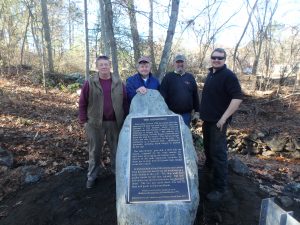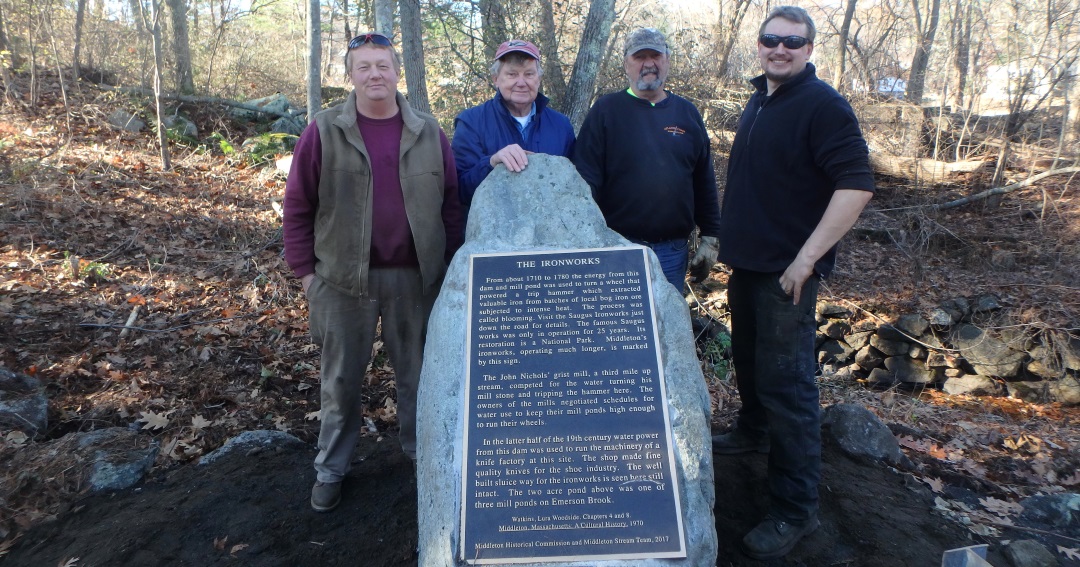Water Closet for December 8, 2017
The Middleton Historical Commission decided in 2016 to mark the site of an important industry here that was started three centuries ago on what is now called Emerson Brook. A dam was built; a mill pond formed behind it with water down from Andover and Reading to provide power. A sluiceway and water wheel were built to run a trip hammer for an ironworks.
Lover of stones Vito Mortalo, here half a century from Italy near Rome, removed a huge stone from a retaining wall around his handsome yard overlooking Emerson Bog and generously donated it to Middleton. He has given and placed for the Stream Team a score of fine stones for its river landing projects in the past two decades. Stream Teamer Leon Rubchinuk, with stone cutting tools and the old Closeteer with hammer and chisel, flattened out a two by three-foot rectangle on one surface of the “manatee” shaped six-foot-tall, three-foot diameter, unevenly fat, natural stone. Other volunteers working on the project called it “lumpy whale” and “bull walrus.” Despite unflattering names, we knew that if Vito approved, it was a good looker for the job. At the May 2017 Town Meeting $2000 was voted for a bronze plaque to tell the Ironwork’s story gleaned from Middleton’s late historian Lura Woodside Watkins’ crackerjack book, The Cultural History of Middleton.

Left to right: Leon Rubchinuk, David Burch, and David Florance maneuvering the three-ton ironwork’s commemorative stone into place. – Sandra Rubchinuk photo
After the hundred-pound plaque arrived from a foundry in Florida, master mason Gerry Gerrior volunteered to attach the bronze to stone. On a fine afternoon with Leon’s help and advice from four old townies looking on and telling stories, the plaque between beers, went elegantly into place. All this in Vito’s lovely yard graced with hundreds of diverse stones collected over the years and nicely arranged. One old timer thought the Manatee would be sad to be moving down stream two miles. Leon then sought help from a friend, a popular businessman in town. Tree man Dave Burch has a large truck with a crane for lifting logs. Leon thought it might be able to transport the town’s stone to its new home where the DPW had prepared a place beside the ironwork’s sluiceway below the dam. Transport went well. At the site on Friday, November 24, things changed. Dave, helper Dave Florance, and Leon, all used to moving heavy things around, found that Manatee had a mind of its own. Maybe it didn’t want to be away from Vito’s where it had been part of a nice wall with long-time friends. After over two hours of tricky maneuvering, the three strong men helped by beams, bars, and three chain falls finally got Manatee, not exactly as planned, into a place. Dave had told us, “It will take its natural position and end up how it wants to rest.” Instead of a vertical plaque as envisioned it stands at a slant and thus is easier to read for those passing on the road. Maybe Manatee gave up and decided further dangerous twisting was only endangering well-meaning volunteers. At one-point Dave yelled at an old kibitzer trying to help by pushing on the swaying stone. “Please! Move away!” We’ll visit now and then to see if homesick Manatee is behaving.

Left to right: David Burch, old Closeteer, Leon Rubchinuk, and David Florance standing behind commemorative stone for the Ironworks just put in place at its 18th century site just below the Mill Pond dam in Middleton – Sandra Rubchinuk photo
If you get a chance drive up Mill Street from Liberty Street or down from Peabody Street to where Emerson Brook flows between the fine old sluiceway walls down under Mill Street to the Ipswich River floodplain. Read the inscription below cemented and bolted to poor Manatee’s back and then walk up the road, parallel to the 200- foot long dam. In your imagination go back 300 years and listen to the turning water wheel and the great trip hammer beating on molten, bog iron ore.
THE IRONWORKS
From about 1710 to 1780 the energy from this dam was used to turn a wheel that powered a trip hammer which extracted valuable iron from batches of local bog iron subjected to intense heat. The process was called blooming. Visit the Saugus Ironworks just down the road for details. The famous Saugus works was only in operation for 25 years. Its restoration is now a National Park. Middleton’s ironworks, operating much longer, is marked by this sign.
The John Nichols’ grist mill, a third mile up stream, competed for the water turning his mill stone and tripping the hammer here. The owners of the mills negotiated schedules for water use to keep their mill ponds high enough to run their wheels.
In the latter part of the 19th century water power from this dam was used to run the machinery for a knife factory at this site. The shop made fine quality knives for the shoe industry. The well-built sluiceway for the ironworks is seen here still intact. The two-acre pond above was one of three mill ponds on Emerson Brook.
Watkins, A Cultural History. Chapters 4 an 8. Middleton: Massachusetts: A Cultural History. 1970
Middleton Historical Commission and Middleton Stream Team 2017
___________________________________________________________
WATER RESOURCE AND CONSERVATION INFORMATION
FOR MIDDLETON, BOXFORD AND TOPSFIELD
| Precipitation Data* for Month of: | Aug | Sept | Oct | Nov | |
| 30 Year Normal (1981 – 2010) Inches | 3.37 | 3.37 | 4.44 | 4.55 | |
| 2017 Central Watershed Actual | 1.22 | 2.44 | 4.03 | 2.6 | |
Ipswich R. Flow Rate (S. Middleton USGS Gage) in Cubic Feet/ Second (CFS):
For Nov 30, 2017 Normal . . . 67 CFS Current Rate . . .18.18 CFS
——————————————————————–
*Danvers Water Filtration Plant, Lake Street, Middleton is the source for actual precipitation data thru Oct..
** Middleton Stream Team is the source of actual precipitation data for Nov.
Normals data is from the National Climatic Data Center.
THE WATER CLOSET is provided by the Middleton Stream Team: www.middletonstreamteam.org or <MSTMiddletonMA@gmail.com>


gula88 hello my website is gula88
Ea388 hello my website is Ea388
hels hello my website is hels
hacker hello my website is hacker
kqxsmb hello my website is kqxsmb
namfare hello my website is namfare
liga mx hello my website is liga mx
js安全 hello my website is js安全